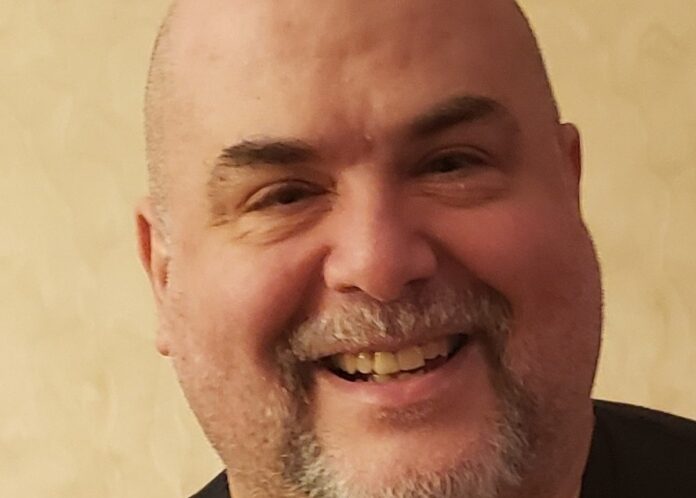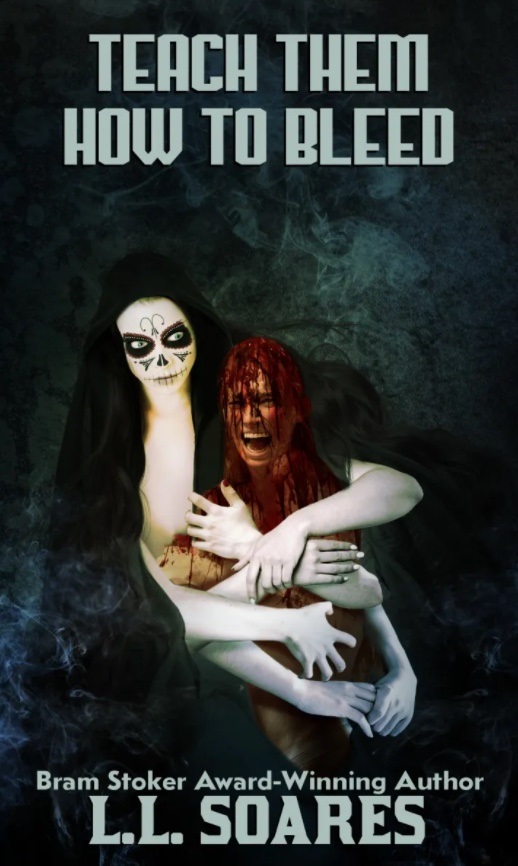L.L. SOARES’s newest book is TEACH THEM HOW TO BLEED, published by Bloodshot Books. His fifth novel, it offers a very different take on vampires. His previous novels are also in print, including LIFE RAGE, ROCK ‘N’ ROLL, HARD, and BURIED IN BLUE CLAY. His first professional story sale was “Little Black Dress” to the horror fiction website “Gothic.net” in 2001. A film criticism column he wrote with Michael Arruda, called “Cinema Knife Fight,” was nominated for the Bram Stoker Award for Nonfiction for 2009, and his novel, LIFE RAGE, won the Stoker Award for Best First Novel for 2012. He lives with his wife and their pet iguana Osiris in the Boston area.
Jonathan Lowe) So tell us a little about your new book.
L.L. Soares) I’ve always strived to do things that are original or to put my own personal twist on familiar concepts, and TEACH THEM HOW TO BLEED continues in this tradition. It’s sort of a vampire story, but not in the way we typically think of vampires. No fangs or capes or crucifixes, but something completely different. First of all – the way you become a vampire is very brutal – and each person becomes their own type of vampire. For example, a woman who is a drug addict finds that she sprouts “needles” all over her skin when it’s time to feed. Another “vampire” will have totally different apparatus to extract blood. It’s also an ensemble novel, featuring several characters – some of whose storylines merge by the end. These other characters include a hunter who eats the hearts of her vampire quarry to gain special powers, and a demonic entity that escapes from confinement to wreak havoc on the world. There are also lots of twists and turns along the way, to keep things interesting.
Jonathan Lowe) Who are your favorite narrators, and why?
L.L. Soares) That’s a tough question. Do you mean, narrators in the way of author’s voices, or actual characters who narrate stories? If you mean characters, then that limits things a lot, since in a lot of books and stories, if written in the third person, you don’t have a narrator per se. But there are a lot of writers I love who have very distinctive voices – you can identify their work from the authorial voice. People like William S. Burroughs, Flannery O’Connor, Charles Bukowski, and Henry Miller. If you mean actual characters who narrate works of fiction, I’d have to say James Ballard, the narrator from J.G. Ballard’s classic novel CRASH; David, the narrator of Jack Ketchum’s THE GIRL NEXT DOOR; Eleanor, the narrator of Shirley Jackson’s THE HAUNTING OF HILL HOUSE; and Franz Westen, the narrator of Fritz Leiber’s OUR LADY OF DARKNESS.
Jonathan Lowe) You’re also an editor, and won a Bram Stoker for criticism. How did that part of your career come about?
L.L. Soares) I’m an editor in my day job, and have been editing my work (and other peoples) for decades now. So it’s a skill I’ve honed over time. As for criticism – we’re mostly talking film criticism – I wrote several movie review columns in the early aughts for a variety of places – and eventually teamed up with writer Michael Arruda on a column called “Cinema Knife Fight,” which ran in one form or another from 2004 to 2018. It was a mix of like a Siskel and Ebert kind of thing – with two distinct voices and points of views – and a more imaginative aspect. We would find ourselves in situations that related to the movies we were reviewing, and there was lots of humor. The column was popular for a few years, and we even got nominated for a Stoker in 2009, but unfortunately we didn’t win. As time went on, Michael went on to other things and I did the column with a revolving cast of other co-writers, until it came to a close. While I wrote for CKF, I went to the movies almost every week, something I would really miss once the pandemic started. I don’t really write movie reviews much anymore, except on social media. But it’s definitely something on my resume.
Jonathan Lowe) For someone just hearing you for the first time, what should they know about horror fiction, and why was that your choice?
L.L. Soares) I have always loved horror. It doesn’t hurt that my birthday is two days away from Halloween. When I was a little kid, I saw FRANKENSTEIN (1931) for the first time on television, and right then I fell in love with the genre, and wanted to somehow be a part of it. Growing up, I saw tons of movies (this was the 70s, so there were tons of Creature Feature-type shows on, and then in the 80s was the VHS boom, which meant suddenly hundreds of movies I had never seen were available to me). So movies were the first thing to grab me, but I was also a big fan of horror literature. In grammar school, I read a lot of Poe and Lovecraft. In high school, I read more science fiction, and started sending stories of my own to magazines. I thought I would get published early and have a long career as a writer, but it was not to be. All I got were rejection slips for years. I sold a story in college to THE MINNESOTAN SCIENCE FICTION READER called “Electroshock Therapy for Mimes,” for $15, but the magazine folded before they could publish it. I wouldn’t sell another story until 2001, when I made my first professional sale to the legendary horror fiction site Gothic.net. The story was called “Little Black Dress.” I think what draws me to horror is that it is a genre that can elicit an involuntary response, either repulsion or fear. I was also always into writers who broke taboos, and horror is the perfect place to do that. I’ve just always liked art that tries to break down boundaries, that takes risks. In art, I don’t think there should be limitations, for the most part, and I was just always drawn to that sort of stuff. Part of it is the thrill of transgression.
My stuff also tends to pull things in from different genres. It’s not unusual for me to add elements of crime fiction, or science fiction, or even fantasy to my work. And in my books, there is a very big emphasis on characters. If someone picks up TEACH THEM HOW TO BLEED without having read other things I’ve written, I think they’ll get a good taste of my style.
Jonathan Lowe) So tell us why you chose to write about vampires in the new book.
L.L. Soares) Growing up, vampires were probably my favorite archetypical monsters. Zombies, for example, can give us some raw scares, but vampires can interact with us on our level, even blend in with us, and yet they’re predators. Over the years, vampires have become a list of tropes where you check things off, and I didn’t want to do it that way. I wanted to get rid of some of the baggage, and sort of reinvent them. I’m definitely not the first person to think that. I didn’t want to deal with stuff like crosses and coffins and bats, and all that more traditional stuff. I like fangs – they can be very effective as a visual metaphor – but they weren’t essential, either.
Vampires have survived in literature because they are adaptive to change. Whether it’s Stoker’s DRACULA or the vampires of Anne Rice, who have a much stronger emotional life, or even Stephanie Meyers’ sparkly TWILIGHT vampires. Even if there’s a take on the subject I’m not a big fan of, I can recognize that each generation is able to adapt vampires in a new way, and it’s this fluidity that keeps them relevant.
Jonathan Lowe) What’s next for you? Any collabs?
L.L. Soares) I have a story in the upcoming New England Horror Writers anthology WICKED SICK, and a career-spanning short story collection coming in 2023 called SOMETHING BLUE And Other Colorful Deaths from Trepidatio Press. Meanwhile, I’m always working on several projects at once. I don’t like to talk too much about works in progress – not because I am superstitious or anything – but because I find, the more I talk about something that’s not written yet to other people, the less interesting it is to me. That said, I am working on a crime fiction novel that is also a mash-up of horror and science fiction. And I have ideas for a sequel to TEACH THEM HOW TO BLEED, expanding on the world of these characters. And a few other things. But which of these actually gets finished is up in the air. As for collaborations – I’ve done several over the years, but nothing I’m currently working on. My first book ever, IN SICKNESS, was a short story collection in collaboration with my wife, writer Laura Cooney, which consists of stories we each wrote separately, and a novella called “In Sickness” that we wrote together. We also wrote the novella GREEN TSUNAMI together. Other authors I’ve collaborated with include Peter N. Dudar, Kurt Newton, and Daniel Keohane (aka G. Daniel Gunn). And of course, “Cinema Knife Fight,” while it existed, was a collaboration I did every week for years, with Michael Arruda and several other writers.
Jonathan Lowe) Where can readers find out more about your work?
L.L. Soares) Well, my books are in print and readily available on all the usual sites, like Amazon and Barnes and Noble. They’re available in electronic (Kindle, etc.) and paperback editions. And you can check out my website, www.llsoares.com. I also have an Author Page on Amazon.
(Jonathan Lowe is a book journalist with 25 years experience, and author of five novels and a latest collection of stories “Gonzo Fun.”)


